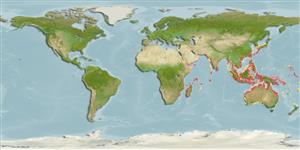Malacostraca |
Stomatopoda |
Squillidae
Environment: milieu / climate zone / djupintervall / distribution range
Ekologi
; djupintervall 2 - 25 m (Ref. 3099). Tropical
Indo-West Pacific.
Length at first maturity / Size / Weight / Age
Könsmognad: Lm ? range ? - ? cm Max length : 16 cm TL (female)
Minimum depth from Ref. 80410. Subtidal (Ref. 106854). Stomatopods are predators that require living prey (Ref. 833).
Life cycle and mating behavior
Könsmognad | Reproduktion | Lek | Eggs | Fecundity | Larvae
Some members of the order Stomatopoda pair for life and some come together only to mate. Males produce sperm ducts rather than spermatophores; females can brood a maximum of 50,000 eggs. Life cycle: Eggs hatch to a planktonic zoea which lasts for 3 months.
Ahyong, S.T. 2001 Revision of the Australian stomatopod Crustacea. Records of the Australian Museum (Suppl. 26):326 p. (Ref. 3099)
IUCN Red List Status
(Ref. 130435: Version 2025-1)
CITES status (Ref. 108899)
Not Evaluated
Not Evaluated
Threat to humans
Harmless
Human uses
| FishSource |
Verktyg
Ytterligare information
Trophic EcologyFood items (preys)
Födosammansättning
Födointag
Predatorer
PhysiologySyreförbrukning
Human RelatedStamps, coins, misc.
Internet-källor
Estimates based on models
Preferred temperature
(Ref.
115969): 23.1 - 29.3, mean 28.3 (based on 3216 cells).
Fishing Vulnerability
Low vulnerability (23 of 100).
